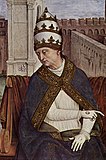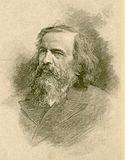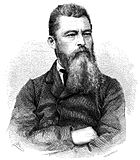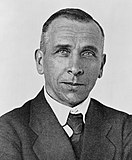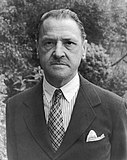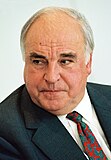Heidelberg University
Ruprecht-Karls-Universität Heidelberg | |
 Sealof theRuperto Carola Heidelbergensis | |
| Motto | Semper apertus(Latin)[1] |
|---|---|
Motto in English | Always open |
| Type | Public |
| Established | 18 October 1386 |
| Budget | €764.9 million (2018)[2] |
| Chancellor | Holger Schroeter |
| President | Frauke Melchior |
Administrative staff | 8,397[3] |
| Students | 28,653(WS2019/20)[4] |
| Undergraduates | 15,289[5] |
| Postgraduates | 11,871[5] |
| 3,024[5] | |
| Location | ,, Germany 49°24′37″N8°42′23″E/ 49.41028°N 8.70639°E |
| Campus | Urban/University town and suburban |
| Colors | Sandstone red and gold |
| Affiliations | German Universities Excellence Initiative,LERU,Coimbra Group,U15,EUA |
| Website | uni-heidelberg |
 | |
| Data as of 2013[update] | |
Heidelberg University,officially theRuprecht Karl University of Heidelberg(German:Ruprecht-Karls-Universität Heidelberg;Latin:Universitas Ruperto Carola Heidelbergensis), is apublicresearch universityinHeidelberg,Baden-Württemberg,Germany.Founded in 1386 on instruction ofPope Urban VI,Heidelberg isGermany's oldest universityand one of theworld's oldest surviving universities;it was the third university established in theHoly Roman EmpireafterViennaandPrague.Since 1899, it has been a coeducational institution.
Heidelberg is one of the most prestigious universities in Germany.[6]It is aGerman Excellence University,part of theU15,as well as a founding member of theLeague of European Research Universitiesand theCoimbra Group.The university consists of twelvefacultiesand offers degree programmes at undergraduate,graduateandpostdoctorallevels in some 100 disciplines.[7]The language of instruction is usually German, while a considerable number of graduate degrees are offered in English as well as some in French.[8][9]
As of 2021,[update]57 Nobel Prize winners have been affiliated with the city of Heidelberg and 33 with the university itself.[10]Modern scientificpsychiatry,psychopharmacology,experimental psychology,psychiatric genetics,Mathematical statistics,[11]environmentalphysics,[12]and modern sociology[13]were introduced as scientific disciplines by Heidelberg students or faculty. Approximately 1,000 doctorates are completed every year, with more than one third of the doctoral students coming from abroad.[14][15]International studentsfrom some 130 countries account for more than 20 percent of the entire student body.[16]
History[edit]
Founding[edit]

TheGreat Schismof 1378 made it possible for Heidelberg, a relatively small city and capital of theElectorate of the Palatinate,to gain its own university.[17]The Great Schism was initiated by the election of two popes after the death ofPope Gregory XIin the same year.[17]One successor resided inAvignon(elected by the French) and the other in Rome (elected by the Italian cardinals).[17]The German secular and spiritual leaders voiced their support for the successor in Rome, which had far-reaching consequences for the German students and teachers in Paris: they lost their stipends and had to leave.[18]
Rupert Irecognized the opportunity and initiated talks with theCuria,which ultimately led to apapal bullfor foundation of a university. After having received, on 23 October 1385, permission from popeUrban VIto create a school of general studies (Latin:studium generale), the final decision to found the university was taken on 26 June 1386 at the behest of Rupert I,Count Palatine of the Rhine.[19]As specified in the papal charter, the university was modelled after theUniversity of Parisand included four faculties: philosophy, theology,jurisprudence,and medicine.[20]
On 18 October 1386 a specialPontifical High Massin theHeiliggeistkirchewas the ceremony that established the university.[19]On 19 October 1386 the first lecture was held,[19]making Heidelberg theoldest university in Germany.[21]In November 1386,Marsilius of Inghenwas elected firstrectorof the university.[22]The rector seal motto wassemper apertus—i.e., "the book of learning is always open."[23]The university grew quickly and in March 1390, 185 students were enrolled at the university.[24]

Late Middle Ages[edit]
Between 1414 and 1418, theology and jurisprudence professors of the university took part in theCouncil of Constanceand acted as counselors forLouis III,who attended this council as representative of the emperor and chief magistrate of the realm. This resulted in establishing a good reputation for the university and its professors.[25]
Due to the influence of Marsilius, the university initially taught thenominalismorvia moderna.In 1412, both realism and the teachings ofJohn Wycliffewere forbidden at the university but later, around 1454, the university decided thatrealismorvia antiquewould also be taught, thus introducing two parallel ways (ambae viae).[26]
The transition fromscholastictohumanisticculture was effected by the chancellor and bishopJohann von Dalbergin the late 15th century. Humanism was represented at Heidelberg University particularly by the founder of the older German Humanistic SchoolRudolph Agricola,Conrad Celtes,Jakob Wimpfeling,andJohann Reuchlin.Æneas Silvius Piccolominiwas chancellor of the university in his capacity as provost ofWorms,and later always favored it with his friendship and good-will asPope Pius II.In 1482,Pope Sixtus IVpermitted laymen and married men to be appointed professors in the ordinary of medicine through a papal dispensation. In 1553,Pope Julius IIIsanctioned the allotment of ecclesiastical benefices to secular professors.[27]
Reformation and modern era[edit]
Martin Luther'sdisputation at Heidelberg in April 1518made a lasting impact, and his adherents among the masters and scholars soon became leadingReformationistsin Southwest Germany. With theElectorate of the Palatinateturn to the Reformed faith,Otto Henry, Elector Palatine,converted the university into acalvinisticinstitution. In 1563, theHeidelberg Catechismwas created under collaboration of members of the university's divinity school.
As the 16th century was passing, the latehumanismstepped besideCalvinismas a predominant school of thought; and figures likePaul Schede,Jan Gruter,Martin Opitz,andMatthäus Meriantaught at the university. It attracted scholars from all over the continent and developed into aculturalandacademiccenter.[28]However, with the beginning of theThirty Years' Warin 1618, the intellectual andfiscalwealth of the university declined. In 1622, the then-world-famousBibliotheca Palatina(the library of the university) was stolen from theUniversity Cathedraland taken to Rome. The reconstruction efforts thereafter were defeated by the troops of KingLouis XIV,who destroyed Heidelberg in 1693 almost completely.[29][30]
As a consequence of the lateCounter-Reformation,the university lost its Protestant character, and was channeled byJesuits.From 1712 to 1728, the Old University was constructed at University Square, then known as Domus Wilhelmina. Through the efforts of theJesuitsa preparatory seminary was established, the Seminarium ad Carolum Borromæum, whose pupils were also registered in the university. After the suppression of the Jesuit Order, most of the schools they had conducted passed into the hands of theFrench Congregation of Lazaristsin 1773. They deteriorated from that time forward.
Meanwhile, the university itself continued to lose in prestige until the reign of the last electorCharles Theodore, Elector Palatine,who established new chairs for all the faculties, founded scientific institutes such as the Electoral Academy of Science, and transferred the school ofpolitical economyfrom Kaiserslautern to Heidelberg, where it was combined with the university as the faculty of political economy. He also founded anobservatoryin the neighboring city ofMannheim,where JesuitChristian Mayerlabored as director. In connection with the four hundredth anniversary of the university, the elector approved a revised statute book that several professors had been commissioned to prepare. The financial affairs of the university, its receipts and expenditures, were put in order. At that time, the number of students varied from 300 to 400; in the jubilee year, 133 matriculated.
As a consequence of the disturbances caused by theFrench Revolution,and particularly because of theTreaty of Lunéville,the university lost all its property on the left bank of theRhine,so that its complete dissolution was expected.[31]
19th and early 20th century[edit]
This decline did not stop until 1803, when the university was reestablished as a state-owned institution byKarl Friedrich, Grand Duke of Baden,to whom the part of the Palatinate situated on the right bank of the Rhine was allotted. Since then, the university bears his name together with the name ofRuprecht I.Karl Friedrich divided the university into five faculties and placed himself at its head as rector, as did also his successors. During this decade,Romanticismfound expression in Heidelberg throughClemens Brentano,Achim von Arnim,Ludwig Tieck,Joseph Görres,andJoseph von Eichendorff,and there went forth a revival of the GermanMiddle Agesin speech, poetry, and art.[28]

The GermanStudents Associationexerted great influence, which was at first patriotic and later political. After Romanticism had eventually died out, Heidelberg became a center of Liberalism and the movement in favor of German national unity.[28]The historiansFriedrich Christoph SchlosserandGeorg Gottfried Gervinuswere the guides of the nation inpolitical history.The modern scientific schools of medicine andnatural science,particularlyastronomy,were models in point of construction and equipment, and Heidelberg University was especially noted for its influential law school.[31]The university as a whole became the role model for the transformation of Americanliberal arts collegesintoresearch universities,in particular for the then-newly establishedJohns Hopkins University.[32]Heidelberg's professors were important supporters of theVormärzrevolution and many of them were members of the first freely elected German parliament, theFrankfurt Parliament of 1848.During the late 19th century, the university housed a very liberal and open-minded spirit, which was deliberately fostered byMax Weber,Ernst Troeltschand a circle of colleagues around them.
In February 1900, theGrand Duchy of Badenissued a decree that gave women the right to access universities in Baden. Thus, the universities of Freiburg and Heidelberg were the first ones to allowwomen to study.
In theWeimar Republic,the university was widely recognized as a center of democratic thinking, coined by professors likeKarl Jaspers,Gustav Radbruch,Martin DibeliusandAlfred Weber.[28]Unfortunately, there were also dark forces working within the university:NaziphysicistPhilipp Lenardwas head of the physical institute during that time. Following the assassination of the liberal German-JewishForeign MinisterWalther Rathenau,he refused tohalf mastthe national flag on the institute, thereby provoking its storming bycommuniststudents.[29]
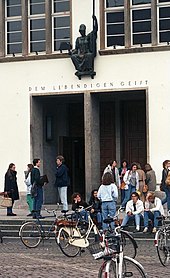
Nazi Germany[edit]
After the establishment ofNazi Germanyin 1933, the university supportedAdolf Hitlerand theNazislike all other German universities at the time. It dismissed a large number of staff and students for political and racial reasons. Many dissident fellows had to emigrate and most Jewish andCommunistprofessors who did not leave Germany were deported. At least two professors directly fell victim to Nazi terror.[33]On 17 May 1933, members of the university faculty and students took part inbook burningsatUniversitätsplatz( "University Square" )[34]and Heidelberg eventually became infamous as aNSDAPuniversity. The inscription above the main entrance of the New University was changed from "The Living Spirit" to "The German Spirit",[35]and many professors paid homage to the new motto. The university was involved inNazi eugenics:forced sterilizations were carried out at the women's clinic and the psychiatric clinic, then directed byCarl Schneider,was involved inAction T4Euthanasiaprogram.[36][37]
The heads of the university helped in the deportation of Jewish men, women and children directly to the gas chambers.[citation needed]
After the end of World War II, the university underwent an extensivedenazification.
Federal Republic of Germany[edit]
Since Heidelberg was spared from destruction during World War II, the reconstruction of the university was realized rather quickly. With the foundation of the Collegium Academicum, Heidelberg University became the home of Germany's first and, until today, only self-governed student hall. Newly laid statutes obliged the university to "The Living Spirit of Truth, Justice and Humanity".[29]
During the 1960s and 1970s, the university grew dramatically in size. At this time, it developed into one of the main scenes of the left-wingstudent protestsin Germany.[38]In 1975, a massive police force arrested the entire student parliamentAStA.Shortly thereafter, the building of the Collegium Academicum, a progressive college in immediate vicinity to the university's main grounds, was stormed by over 700 police officers and closed once and for all. On the outskirts of the city, in the Neuenheimer Feld area, a large campus for medicine andnatural scienceswas constructed.[29]
Today, about 28,000 students are enrolled for studies at Heidelberg University.[39]There are 4,196 full-time faculty, including 476 university professors.[15]In 2007, and again in 2012, the university was appointedUniversity of Excellenceunder an initiative started by theFederal Ministry of Education and Researchand theGerman Research Foundation.This enhanced the German university system by establishing a small network of exceptionally well-funded universities, which are expected to generate strong international appeal.[40]
In 2022,a mass shooting occurred in the university,killing a woman and injuring three other people. The gunman then committed suicide.[41]
Campuses[edit]
|
"I saw Heidelberg on a perfectly clear morning, with a pleasant air both cool and invigorating. The city, just so, with the totality of its ambiance is, one might say, something ideal." |
| —Johann Wolfgang von Goethe[42] |
Heidelberg is a city with approximately 140,000 inhabitants. It is situated in theRhine Neckar Triangle,aEuropean metropolitan areawith approximately 2.4 million people living there, comprising the neighboring cities ofHeidelberg,Mannheim,Ludwigshafen,and a number of smaller towns in the perimeter. Heidelberg is known as the cradle ofRomanticism,and its old town andcastleare among the most frequented tourist destinations in Germany. Its pedestrian zone is a shopping and night life magnet for the surrounding area and beyond. Heidelberg is about 40 minutes by train away fromFrankfurt International Airport.[43] Heidelberg University's facilities are, generally speaking, separated in two parts. The faculties and institutes of humanities and social sciences are embedded in the Old Town Campus. The sciences faculties and the medical school, including three large university hospitals, are located on the New Campus in the Neuenheimer Feld on the outskirts of Heidelberg.[44]
Old Town Campus[edit]
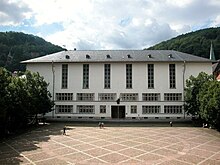
The so-called New University is regarded as the center of the Old Town Campus. It is situated at theUniversitätsplatz(University Square) in the pedestrian zone, in direct vicinity to the University Library and to the main administration buildings. The New University was officially opened in 1931. Its erection was largely financed by donations of wealthy American families, in line with a fundraising campaign ofJacob Gould Schurman,an alumnus of Heidelberg University and formerUnited States Ambassador to Germany.[45]It houses the new assembly hall, the largest lecture halls, and a number of smaller seminar rooms, mostly used by faculties of humanities and social sciences. Education in humanities and social sciences takes place to a great extent in buildings spread over the ancient part of town, though most are less than ten minutes walk from University Square. The faculties maintain their own extensive libraries and work spaces for students. Seminars and tutorials are usually held in the faculty buildings.[44]
Neuenheimer Feld – New Campus[edit]
In the 1960s the university started building a new campus near the city district Neuenheim, called the Neuenheimer Feld. It is today the largest part of the university, and the largest campus for natural sciences and life science in Germany.[15]Almost all science faculties and institutes, the medical school,University Hospital Heidelberg,and the science branch of the University Library are situated on the New Campus. Most of the dormitories and the athletic facilities of the university can be found there as well.
Several independent research institutes, such as theGerman Cancer Research Centerand two of theMax-Planck-Instituteshave settled there. The New Campus is also the seat of several biomedical spin-off companies. The old part of town can be reached by tram and bus in about 10 minutes. The Neuenheimer Feld campus has extensive parking lots for faculty and student vehicles for long term and short term parking, as well as visitors and patients of the various university hospitals. The Faculty of Physics and Astronomy is not located on either campus, but on thePhilosophers' Walk,separated from the Old Town by the River Neckar, and some 2 km (1.2 mi) away from the New Campus. It also maintains observatory facilities on theKönigstuhl Mountain.[44]
The university maintainsa botanical gardenat Neuenheimer Feld.[46]
Bergheim Campus[edit]

The Bergheim Campus is located in the former Ludolf Krehl clinic (named afterLudolf von Krehl) in the inner-city suburb ofHeidelberg-Bergheim.Since March 2009 it has housed the institutes economics, political science, and sociology (together the Heidelberg University Faculty of Economics and Social Sciences) that formerly resided at the Old Town campus. The Bergheim campus offers one lecture theatre, several seminar rooms, the most modern of the university libraries, and a cafe (rather than the full cafeteria present in the other campuses). Since 2019, the Bergheim Campus has also become the location of theCentre for Asian and Transcultural Studiesof the Heidelberg University.
Libraries[edit]
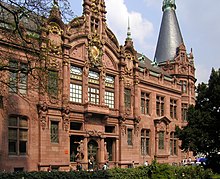
The University Library is the main library of the university. Together with the branch libraries, serving the faculties and institutes, it forms the integral university library system comprising approximately 6.2 million printed volumes. The University Library's holdings exceeded one million in 1934. Today, it comprises about 3.2 million books, about 500,000 other media such as microfilms and video tapes, as well as 6,000 printed scientific periodicals. Moreover, it has 6,900 manuscripts, 1,800incunabula,110,500autographs,and a collection of old maps, paintings, and photographs. Furthermore, the 38 branch libraries add another 3.0 million printed books. In 2022, 43,600 active users accessed 746,000 books. Additionally, the University Library provides a wide array of online resources, among them 152,000 scientifice-journals.[47]
The origins of today's University Library date back to 1386, the year the university was founded. Surrounding the new university, the libraries of the faculty of the arts, the three higher faculties (theology, law, medicine) and the collegiate library grew. The acquisition of a box of records, which was housed in theHeiliggeistkirche,through the rector,Marsilius of Inghen,in 1388 contributed fundamentally to the development of the library. In the 16th century,Otto Henry, Elector Palatine,combined the miscellaneous book collections accrued since the foundation of the university with the princely library housed inHeidelberg Castleto form theBibliotheca Palatinaand made them publicly accessible in the galleries of theHeiliggeistkirche.Among these collections, inherited records of the Fuggers (Augsburg, Ulrich Fugger the Elder) wereof particular importance. The majority of the library holdings, which enjoyed great contemporary renown, was looted during theThirty Years' War,transported toRomeand was gifted toPope Gregory XVby the victoriousMaximilian I, Elector of Bavariain 1622. After the secularization in 1804, the holdings of the monasteries of Salem and Petershausen formed the foundation of the reconstruction of the library collection in the 19th century. In 1816, 847 German-language manuscripts from theBibliotheca Palatinareturned to Heidelberg. As part of an exchange, theCodex Manesse,which had ended up in the Royal Library in Paris, followed in 1888.Karl Zangemeister(1837–1902) became the first full-time head of the university library in 1912. Based on the designs of architect Joseph Durum, a dedicated library building, a richly ornamented, four-winged red sandstone construction, was erected from 1901 to 1905. In 1978, a branch library opened in the Neuenheimer Feld, serving the institutes of natural sciences and medicine.
Since 2021, all manuscripts of theBibliotheca Palatinaare accessible digitally online (848 German-language Palatina manuscripts, 2,030 Latin, 423 Greek, 267 Hebrew and 20 manuscripts in other languages).[48]Their digitization was achieved through the cooperation of Heidelberg University Library and theVatican Library.
The university library expands its publication services: The Heidelberg document server heiDOK is an open access platform for members of the university. The university bibliography heiBIB lists all academic publications by university members. In 2015, Heidelberg University founded the publishing house Heidelberg University Publishing – heiUP, which is part of the university library. The publisher releases quality-controlled scientific publications in open access.
Facilities abroad[edit]
Heidelberg University founded aCenter for Latin AmericainSantiago, Chilein 2001.[49]It has the task of organizing, managing, and marketing the courses of study maintained either independently by Heidelberg University or in cooperation with thePontifical Catholic University of Chileand theUniversity of Chile.The center has responsibility for programs ofpostgraduate education.It also coordinates the activities of Heidelberg University in Latin America, and provides a platform for scientific cooperation.[49]Heidelberg University'sSouth Asia Institutemaintains branch offices in New Delhi (India)),Islamabad(Pakistan),Kathmandu(Nepal), andColombo(Sri Lanka).[50]
The university is also represented by a liaison office in New York. Its main tasks include promoting existing collaborations, building up new networks, creating joint study programs, and maintaining and expanding academic contacts with American universities.[51]
Museum[edit]
The university has its own museum, in the main building of the old campus. Visitors are able to view the Great Hall (when not in use), and the former "student jail".[52]
Organization[edit]
Governance[edit]
TheRectorateis the 'executive body' of the university, headed by rectorBernhard Eitel.The rectorate consists of thechancellor,Holger Schroeter,who is the head of the central administration and responsible for the university's budgeting, and three pro-rectors, who are responsible for international relations, teaching and communication, and research and structure respectively.
TheSenateis the 'legislative branch' of the university. The rector and the members of the rectorate are senatorsex officio,as are also thedeansof the faculties, as well as the medical and managing directors of theUniversity Hospital,and the university'sequal opportunities officer.Another 20 senators are elected for four-year terms, within the following quotas: eight university professors; four academic staff; four delegates of thestudent body;and four employees of the university administration.
TheUniversity Councilis the advisory board to the aforementioned entities and encompasses, among others, the former Israeli Ambassador to GermanyAvi Primor,as well as CEOs of German industries.[53]
Faculties[edit]
After a 2003 structural reformation, the university consists of 13faculties,which in turn comprise several disciplines, departments, and institutes. As a consequence of theBologna process,most faculties now offerBachelor's,Master's,andPh.D. degreesto comply with the new European degree standard. Notable exceptions are the undergraduate programs in law, medicine,dentistryandpharmacy,from which students still graduate with theState Examination,a central examination at Master's level held by the State of Baden-Württemberg.
- The Faculty of Behavioural Sciences and Empirical Cultural Sciences
- The Faculty of Biosciences
- The Faculty of Chemistry and Earth Sciences
- The Faculty of Engineering[54]
- The Faculty of Law
- The Faculty of Mathematics and Computer Science
- The Faculty of Medicine
- The Faculty of Medicine in Mannheim
- The Faculty of Modern Languages
- The Faculty of Philosophy and History
- The Faculty of Physics and Astronomy
- The Faculty of Theology
- The Faculty of Economics and Social Sciences
Associated institutions[edit]
- Network for Research on Ageing
- Central Institute of Mental Health Mannheim
- Heidelberg Center for American Studies
- Heidelberg Institute for International Conflict Research,
- Heidelberg State Observatory,[55]
- University Hospital Heidelberg,
- University Hospital Mannheim
Partnerships[edit]
The university has partnerships nationally and internationally. In particular, it maintains longstanding collaborations in research and education with the following independent research institutes located in and around Heidelberg:
- Center for Jewish Studies Heidelberg
- European Molecular Biology Laboratory
- German Cancer Research Center(Helmholtz Association)
- Heavy Ion Research Center Darmstadt(Helmholtz Association),
- HeidelbergUniversity of Education
- Heidelberg Academy of Sciences
- Karlsruhe Research Center(Helmholtz Association)
- Max Planck Institute for Astronomy(Max Planck Society)
- Max Planck Institute for Comparative Public Law and International Law(Max Planck Society)
- Max Planck Institute for Medical Research(Max Planck Society)
- Max Planck Institute for Nuclear Physics(Max Planck Society)
Academic profile[edit]
School statistics[edit]
The university employs more than 15,000 academic staff; most of them are physicians engaged in theUniversity Hospital.[56]As of 2008, the faculty encompasses 4,196 full-time staff, excluding visiting professors as well asgraduateresearchandteaching assistants.673 faculty members have been drawn from abroad. Heidelberg University also attracts more than 500 international scholars as visiting professors each academic year. The university enrols a total of 26,741 students, including 5,118 international students. In addition there are 1,467 internationalexchange studentsat Heidelberg. 23,636 students pursue taught degrees, 4,114 of whom are international students, and 919 are international exchange students. 3,105 students pursue adoctoral degree,including 1,004 international doctoral students and 15 internationalexchange students.In 2007, the university awarded 994PhD degrees.[39]
Rankings[edit]
| University rankings | ||||||||||||||||
|---|---|---|---|---|---|---|---|---|---|---|---|---|---|---|---|---|
| Overall – Global & National | ||||||||||||||||
| ||||||||||||||||
| By subject – Global & National | ||||||||||||||||
| ||||||||||||||||
In the 2025 edition of theQS World University Rankings,Heidelberg ranked 84th globally and 3rd in Germany.[57]According to the 2024Times Higher Education World University Rankings,the university was ranked 47th in the world and held the position as the 3rd best university in the country.[58]Moreover, in the 2023ARWU World Rankings,Heidelberg secured the 55th position worldwide and was ranked first nationally.[59]
According to the funding report of theGerman Research Foundation(DFG) of 2018, which breaks down the grants from 2014 to 2016, the Heidelberg University ranked 2nd among German universities in the overall ranking, 7th inhumanitiesandsocial sciencesand 4th among German universities in thelife sciencesandnatural sciences.The approvals were normalised to the size of the university. In a competitive selection process, the DFG selects the best research projects from researchers at universities and research institutes and finances them. The ranking is thus regarded as an indicator of the quality of research.[63]
In thePerformance Ranking of Scientific Papers for World Universities(NTU ranking) 2019, which measures the research outputs of universities, Heidelberg University is ranked 1st in Germany and 5th in Continental Europe.[64]
In theCWTS Leiden Ranking2019 Heidelberg University is ranked 1st in Germany and 13th in Continental Europe over all sciences according to the scientific impact (number of publications in core journals). According to the indicator "Collaboration", Heidelberg University is 1st in Germany and 10th in Europe.[65]
Ranked by the number ofNobel Laureatesaffiliated with the university at the time of Nobel Prize announcement, Heidelberg was placed 1st in Germany, 4th in Europe and 13th in the world by 2013.[66]
According to theThird European Report on Science & Technology Indicatorscompiled by theEuropean Commission,Heidelberg ranked 4th nationally and 9th in Europe.[67][68]
The GermanCenter for Higher Education DevelopmentExcellence Ranking 2010, which measures academic performance of European graduate programs in biology, chemistry, economics, mathematics, physics, political sciences, and psychology, placed Heidelberg in the European excellence group for biology, chemistry, mathematics, physics, and psychology.[69]
Measured by the number of top managers in the German economy, Heidelberg University ranked 53rd in 2019.[70]
|
| |||||||||||||||||||||||||||||||||||||||||||||||||||||||||||||||||||||||||||||||||||||||||||||||||||||||||||||||||||||||||||||||||||||||||||||||||||||||||||||||||||||||||||||||||||||||||||||||||||||||||||||||||||||||||||
Organisation and length of courses[edit]
The academic year is divided into twosemesters.The winter semester runs from 1 October to 31 March and the summer semester from 1 April to 30 September. Classes are held from mid-October to mid-February and mid-April to mid-July. Students can generally begin their studies either in the winter or the summer semester. However, there are several subjects students can begin only in the winter semester. The standard time required to finish aBachelor's degreeis principally six semesters, and a further four semesters for consecutiveMaster's degrees.The normal duration of PhD programmes for full-time students is 6 semesters. The overall period of study for an undergraduate degree is divided into two parts: a period of basic study, lasting at least four semesters, at the end of which students must sit a formalexamination,and a period of advanced study, lasting at least two semesters, after which students take their final examinations.[71]
Admission[edit]
In the winter-semester 2006/2007, the university offered 3,926 places in undergraduate programs restricted bynumerus clausus,with an overall acceptance rate of 16.3%.[72]Most selective are the undergraduate programs in clinical medicine, molecular biotechnology, political science, and law, with acceptance rates of 3.6%,[73]3.8%,[72]7.6%[74]and 9.1%[75]respectively. The selection is exercised by allocating the best qualified applicants to a given number of places available in the respective discipline, thus depending primarily on the chosen subjects and the grade point average of theAbituror its equivalent. For some majors and minors in humanities—particularly for conceptually non-vocational like classics and ancient history—unrestricted admission is granted under certain criteria (e.g., relevant language proficiency), as applications regularly do not exceed the number of places available.

For prospective international undergraduate students, a language test for German—such as theDSH—is required. Admission to consecutive Master's programs always requires at least an undergraduate degree equivalent to the German grade "good" (i.e., normally B+ in American, or 2:1 in British terms). Except for the Master's programs taught in English, a language test for German must be passed as well. PhD admission prerequisite is normally a strong Master's-level degree, but specific admission procedures vary and cannot be generalized.[76]International applicants usually make up considerably more than 20% of the applicant pool and are considered individually by the merits achieved in their respective country of origin.[77]
Finances[edit]
The German state heavily subsidizes university study to keep higher education affordable regardless of socio-economic background.[78] From 2007 to 2012, Heidelberg has charged tuition fees of approximately €1,200 p.a. for undergraduate, consecutive Master's, and doctoral programs, for both EU and non-EU citizens, and for any subject area. However, from spring term 2012 onwards, tuition fees have been abolished.[79]The usual housing costs for on-campus dormitories range from €2,200 to €3,000 p.a.[80]
In the fiscal year 2005, Heidelberg University had an overalloperating budgetof approximately €856 M, consisting of approximately €413 M government funds, approximately €311 M basic budget, and approximately €132 M from external grants. The university spent approximately €529 M in payroll costs and approximately €326 M in other expenditures.[81]Additionally, the university receives another €150 M in research grants, distributed over 5 years from 2012 onwards, due to theGerman Universities Excellence Initiative.In the fiscal year 2007, the university for the first time raised approximately €19 M through tuition fees, exclusively to further improve the conditions of study. Only approximately €9.5 M of these were spent at the end of the year and the rectorate had to urge the faculties to make use of their additional means.[82]
Research[edit]
Among historical scientific achievements of Heidelberg researchers features prominently the invention ofspectroscopy,[83]and of theBunsen burner;[84]the discovery of chemical elementsCaesiumandRubidium;[83]the identification of theabsolute point of ebullition;[85]and the identification and isolation ofnicotineas the mainpharmacologicallyactive component of tobacco.[86]Modern scientificpsychiatry;psychopharmacology;psychiatricgenetics;[11]environmentalphysics;[12]and modern sociology[13]were introduced as scientific disciplines by Heidelberg faculty. Almost 800dwarf planets,theNorth America Nebula,and the return ofHalley's Comethave been discovered and documented at institutes of theHeidelberg Center for Astronomy.[87]Moreover, Heidelberg researchers invented the process ofplastinationto preservebody tissue,[88]conducted the first successful transplantation ofhematopoietic stem cells,[89]and recently developed a new strategy for avaccinationagainst certain forms of cancer, which earnedHarald zur Hausenof the university theNobel Prize in Physiology or Medicine2008.[90]
Today, the university puts an emphasis on natural sciences and medicine, but it retains its traditions with highly ranked faculties of humanities and social sciences. TheMarsilius Kolleg,named afterMarsilius of Inghen,was established in 2007 as a Center for Advanced Study to promote interdisciplinary dialogue and research especially between the sciences and the humanities.[91]Other institutes such as theInterdisciplinary Center for Scientific Computing,theInterdisciplinary Center for Neurosciences,theHeidelberg Center for American Studies,and theSouth Asia Institutealso build a bridge between faculties and thus emphasize the concept of a comprehensive university.
Noted regular publications of theCenter for Astronomyinclude theGliese catalogue of nearby stars,the fundamental cataloguesFK5andFK6and the annual publishedApparent places,a high precision catalog with pre-calculated positions for over 3,000 stars for each day.[92]TheHeidelberg Institute for International Conflict Researchpublishes the annualConflict Barometer,which describes the recent trends in global conflict developments, escalations, de-escalations, and settlements.[93]Regular publications by theMax Planck Institute for International Lawinclude theHeidelberg Journal of International Law,theMax Planck Yearbook of United Nations Law;theJournal of the History of International Law;theMax Planck Encyclopedia of Public International Law;and the semi-annual bibliographyPublic International Law.[94]
TheGerman Research Foundation(DFG) currently funds twelve long-termCollaborative Research Centers(SFB) with a duration of up to 12 years at Heidelberg,[95]four Priority Programs (SPP) with a duration of six years, two Research Units (FOR) with a duration of up to six years, as well as numerous individual projects at the university's faculties and institutes.[96]As a result of theGerman Universities Excellence Initiative,two Clusters of Excellence are funded with €6.5 M each— "Cellular Networks: From Molecular Mechanisms to Quantitative Understanding of Complex Functions",[97]and"Asia and Europe in a Global Context".[98]
International cooperations[edit]
Heidelberg is a founding member of theLeague of European Research Universities,theCoimbra Group,and theEuropean University Association.The university forms part of the German-Japanese University Consortium HeKKSaGOn, and it participates in 7 European exchange schemes for researchers and students, such asERASMUS.Furthermore, it is actively involved in the development of the German-speakingAndrássy University of Budapest,and co-runs the school of German law at theJagiellonian University of Kraków.[99]The city of Heidelberg being twinned withCambridge, England,andMontpellier, France,there are close academic ties to theUniversity of Cambridgeand theUniversité de Montpellier.Beyond Europe, the university and its faculties maintain specific agreements with 58 partner universities in Africa, the Americas, Asia, Australia and theRussian Federation.In total, the Higher Education Compass of the German Rector's Conference lists staff and student exchange agreements as well as research cooperations with 236 universities worldwide. Some of the most notable partner universities includeCornell University,Duke University,Georgetown University,Harvard University,Paris Institute of Political Studies (Sciences Po),Pantheon Sorbonne University,University of Cambridge,University of Oxford,Tsinghua University,andYale University.[100]
Student life[edit]
Sports[edit]

The university offers a broad variety of athletics, such as teams in 16 different court sports fromAmerican footballto volleyball, courses in 11 different martial arts, 26 courses inphysical fitnessandbody building,9 courses in health sports from aquapower toyoga,and groups in 12 different dance styles. Moreover,equestrian sports,sailing,rowing,skiingin the French Alps, track and field, swimming,fencing,cycling,acrobatics,gymnastics, and much more. Most of the sports are free of charge.[101]Heidelberg's competition teams are particularly successful in soccer, volleyball, equestrian sports, judo, karate, track and field, and basketball. The University Sports Club men's basketball team,USC Heidelberg,is the championship record holder, won 13 national championships, and is the only university team playing at a professional level in thesecond division of Germany's national league.[102]
Groups[edit]
Moreover, the university supports a number of student groups in various fields of interest. Among them are four drama clubs, the university orchestraCollegium Musicum,four choirs, six student media groups, six groups of international students, nine groups of political parties and NGO's, several departments of European organizations of students in certain disciplines, four clubs dedicated to fostering international relations and cultural exchange, a chess club, a literature club, two debate societies (one focused on English debating, the other focused on German debating), one student consulting group, and four religious student groups. Student unions structure themselves as "Studierendenrat" (Student body council) as well as on department level.[103]
Media[edit]
Heidelberg's student newspaper "ruprecht"is—with editions of more than 10,000 copies—one of Germany's largest student-run newspapers. It was recently distinguished by theMLPPro Campus Press Award as Germany's best student newspaper. The jury of journalists from major newspapers commended its "well balanced, though critical attitude" and its "simply great" layout that "suffices highest professional demands." The ruprecht is financed entirely by advertising revenues, thus retaining independence from university management. Some renowned journalists emerged fromruprecht's editorial board.[104]
However, the critical online student newspaperUNiMUT,which is run by the joint student council of the faculties, criticized theruprechtoften for being conformed, and exceedingly layout-oriented.[105]
Heidelberg is also home of Germany's oldest studentlaw reviewHeidelberg Law Review.The journal is published quarterly, at the beginning and end of each semester break, and is circulated throughout all of Germany.[106]
Studentenverbindung[edit]
Heidelberg hosts 34 studentcorporations,which were largely founded in the 19th century. Corporations are to some extent comparable to thefraternitiesin the US. As traditional symbols (couleur) corporation members wear colored caps and ribbons at ceremonial occasions (Kommers) and some still practice the traditionalacademic fencing,a kind of duel, to "shape their members for the challenges of life." In the 19th and early 20th century, corporations played an important role in Germany's student life. Today, however, corporations include only a relatively small number of students. Their self-declared mission is to keep academic traditions alive and to create friendships for life. The corporations' often representative 19th-century mansions are present throughout the Old Town.
Nightlife[edit]
Heidelbergis not least famous for its student night life.[107]Besides the various parties regularly organized by the student councils of the faculties, the semester opening and closing parties of the university, the dormitory parties, and the soirées of Heidelberg's 34 student fraternities, the city offers night life for any taste and budget.[citation needed]
Notable alumni[edit]
Alumni and faculty of the university include many founders and pioneers ofacademic disciplines,and a large number of internationally acclaimed philosophers, poets,jurisprudents,theologians,naturalandsocial scientists.33 Nobel Laureates, at least 18Leibniz laureates,and two"Oscar" winnershave been associated with Heidelberg University. NineNobel laureatesreceived the award during their tenure at Heidelberg.[66]
Besides severalfederal ministers of Germanyand prime ministers ofGerman states,fivechancellors of Germanyhave attended the university, the latest beingHelmut Kohl,the "Chancellor of the Reunification".Heads of stateorgovernmentof Belgium,Bulgaria,Greece,Nicaragua,Serbia,Thailand,a Britishheir apparent,asecretary general of NATOand a director of theInternational Peace Bureauhave also been educated at Heidelberg; among themNobel Peace laureatesCharles Albert GobatandAuguste Beernaert.Former university affiliates in the field of religion includePope Pius II,cardinals,bishops, and withPhilipp MelanchthonandZacharias Ursinus,two key leaders of theProtestant Reformation.Outstanding university affiliates in the legal profession include a president of theInternational Court of Justice,two presidents of theEuropean Court of Human Rights,a president of theInternational Tribunal for the Law of the Sea,a vice president of theInternational Criminal Court,anadvocate generalat theEuropean Court of Justice,at least 16justicesof theFederal Constitutional Court of Germany,a president of theFederal Court of Justice,a president of theFederal Court of Finance,a president of theFederal Labor Court,twoattorneys general of Germany,and a Britishlaw lord.In business, Heidelberg alumni and faculty notably founded, co-founded or presided overABB;Astor corporate enterprises;BASF;BDA;Daimler AG;Deutsche Bank;EADS;Krupp AG;SiemensandThyssen AG.
Alumni in the field of arts include classical composerRobert Schumann,philosophersLudwig FeuerbachandEdmund Montgomery,poetJoseph Freiherr von Eichendorffand writersChristian Friedrich Hebbel,Gottfried Keller,Irene Frisch,Heinrich Hoffmann,Sir Muhammad Iqbal,National Hero of the PhilippinesJosé Rizal,W. Somerset Maugham,Jean Paul,Literature Nobel laureateCarl Spitteler,and novelistJagoda Marinić.Amongst Heidelberg alumni in other disciplines are the "Father of Psychology"Wilhelm Wundt,the "Father of Physical Chemistry"J. Willard Gibbs,the "Father of American Anthropology"Franz Boas,Dmitri Mendeleev,who created theperiodic tableof elements, inventor of thetwo-wheeler principleKarl Drais,Alfred Wegener,who discovered thecontinental drift,as well as political theoristHannah Arendt,gender theoristJudith Butler,political scientistCarl Joachim Friedrich,and sociologistsKarl Mannheim,Robert E. ParkandTalcott Parsons.
PhilosophersGeorg Wilhelm Friedrich Hegel,Karl Jaspers,Hans-Georg Gadamer,andJürgen Habermasserved as university professors, as did also the pioneering scientistsHermann von Helmholtz,Robert Wilhelm Bunsen,Gustav Robert Kirchhoff,Emil Kraepelin,the founder of scientific psychiatry, and outstanding social scientists such asMax Weber,the founding father of modern sociology.
Present faculty includeMedicine Nobel LaureatesBert Sakmann(1991) andHarald zur Hausen(2008),Chemistry Nobel LaureateStefan Hell(2014), seven Leibniz laureates, former justice of theFederal Constitutional Court of GermanyPaul Kirchhof,andRüdiger Wolfrum,the former president of theInternational Tribunal for the Law of the Sea.
In fiction and popular culture[edit]
Literature[edit]
In 1880Mark Twainhumorously detailed his impressions of Heidelberg's student life inA Tramp Abroad.He painted a picture of the university as a school for aristocrats, where students pursued a dandy's lifestyle, and described the great influence the student corporations exerted on the whole of Heidelberg's student life.[108]
InWilliam Somerset Maugham's 1915 masterpiece novelOf Human Bondage,he described the one-year stay of the protagonist Philip Carey at Heidelberg University, in a largely autobiographical way. Heidelberg also featured in the respective film versions of the novel, released in1934(starringLeslie Howardas Philip, andBette Davisas Mildred),1946(withPaul HenreidandEleanor Parkerin the lead roles), and1964(withLaurence HarveyandKim Novakin the lead roles).[109]
E. C. Gordon, the hero ofRobert Heinlein's 1964 novelGlory Road,mentions his desire for a degree from Heidelberg and thedueling scarsto go with it.
InBernhard Schlink's semi-autobiographical 1995 novelThe Reader,Heidelberg University is one of the main scenes of Part II. Nearly a decade after his affair with an older woman came to a mysterious end, Michael Berg, a law student at the university, re-encounters his former lover as she defends herself in a war-crimes trial, which he observes as part of a seminar. The university is also featured in theAcademy Award-winning 2008 film versionThe Reader,starringKate Winslet,David KrossandRalph Fiennes.[110][111]
Film and television[edit]
The 1927 silent filmThe Student Prince in Old Heidelberg,based onWilhelm Meyer-Förster's playAlt Heidelberg(1903), starringRamón NovarroandNorma Shearer,continued Mark Twain's image of Heidelberg, showing the story of a German prince who comes to Heidelberg to study there, but falls in love with his innkeeper's daughter. Having been very popular in the first half of the 20th century, it presents the typical student life of the 19th and early 20th century, and it is today considered a masterpiece of the late silent film era.[112]MGM's 1954 color remakeThe Student Prince,featuring the voice ofMario Lanza,is based onSigmund Romberg'soperetta version of the story.[113]In 2000, a film namedAnatomy (film)withFranka Potentewas set at Heidelberg and involved a secret society called the Anti-Hyppocratic Society.
See also[edit]
- List of medieval universities
- Mannheim University of Applied Sciencesfor jointly run programs
- Rhine Neckar Metropolitan Area
Notes[edit]
- ^"Mission Statement".uni-heidelberg.de.Archivedfrom the original on 17 May 2017.Retrieved13 April2017.
- ^"Daten und Fakten – Finanzen".Universität Heidelberg.Archivedfrom the original on 29 October 2018.Retrieved26 March2020.
- ^"Daten und Fakten – Personal".Universität Heidelberg.Archivedfrom the original on 4 March 2016.Retrieved26 March2020.
- ^"Kennzahlen Studium – Studierende und Wissenschaftlicher Nachwuchs".Universität Heidelberg.Archivedfrom the original on 26 March 2020.Retrieved26 March2020.
- ^abc"Studierendenstatistik WS 2012/2013"(PDF).www.uni-heidelberg.de(in German).Archived(PDF)from the original on 31 January 2017.Retrieved2 December2013.
- ^Schönmann, Jochen (20 October 2007)."Elite-Uni Heidelberg: Der Stolz der alten Dame".Der Spiegel.Archivedfrom the original on 11 December 2022.Retrieved11 December2022.
- ^The university does not include departments ofbusiness,visual arts, and engineering, except for computer engineering. For a list of subjects offered see"Subjects offered at Heidelberg University".Heidelberg University(in German).Archivedfrom the original on 27 September 2017.Retrieved2 October2010.
- ^"List of courses on offer at Heidelberg University".Heidelberg University.Archivedfrom the original on 17 September 2017.Retrieved21 July2016.
- ^"Über uns – HEIPAR e. V".Archivedfrom the original on 26 September 2020.Retrieved17 December2019.
- ^Watzke, Christian."Nobel Laureates affiliated with Heidelberg University – Heidelberg University".www.uni-heidelberg.de.Archived(PDF)from the original on 10 November 2012.Retrieved17 March2018.
- ^abBurgmair, Wolfgang; Eric J. Engstrom; Matthias Weber; et al. (2000–2008).Emil Kraepelin. 7 vols.Vol. V: Kraepelin in Heidelberg, 1891–1903 (2005). Munich: Belleville.ISBN978-3-933510-94-5.
- ^ab"Department of Physics and Astronomy".Heidelberg University.Archivedfrom the original on 23 September 2017.Retrieved26 September2010.
- ^abPetersen, William.Against the Stream: Reflections of an Unconventional Demographer.Transaction Publishers. p. 24.ISBN978-1-4128-1666-3.
- ^"Graduate Academy of the University of Heidelberg".Heidelberg University Homepage.Archived fromthe originalon 15 December 2007.Retrieved16 May2008.
- ^abc"Interview with Rector Bernhard Eitel – Vorstoss in die internationale Dimension".Rhein Neckar Zeitung online.Archived fromthe originalon 11 April 2008.Retrieved16 May2008.
- ^"Heidelberg Research Magazine Ruperto Carola 1/2004".Heidelberg University Homepage.Archived fromthe originalon 3 March 2016.Retrieved16 May2008.
- ^abcCser 2007,p. 31
- ^Wolgast 1986,p. 1–2
- ^abcWolgast 1986,p. 3
- ^Hermans, Jos. M. M.; Nelissen, Marc, eds. (2005).Charters of Foundation and Early Documents of the Universities of the Coimbra Group.Varia Letteren (2 ed.). Leuven University Press. pp. 56–57.ISBN978-90-5867-474-6.
- ^Wolgast 1986,p. 1
- ^Cser 2007,p. 39
- ^Wolgast 1986,p. 5–6
- ^Cser 2007,p. 40
- ^Cser 2007,p. 43
- ^Gabriel 1974,pp. 459–61
- ^"Heidelberg University – Catholic Encyclopedia".Catholic Online.Archivedfrom the original on 9 September 2017.Retrieved16 May2008.
- ^abcdCser 2007,p.[page needed]
- ^abcd"History of the University".Heidelberg University Homepage.Archived fromthe originalon 19 December 2007.Retrieved16 May2008.
- ^"A history of the Church of St. Peter".Heidelberg University Homepage.Archived fromthe originalon 2 January 2008.Retrieved16 May2008.
- ^abHerbermann, Charles, ed. (1913)..Catholic Encyclopedia.New York: Robert Appleton Company.
- ^"When German Universities were Models for American Universities".atlanticreview.org.Archived fromthe originalon 19 December 2016.Retrieved10 January2010.
- ^Wolgast 1986,p. 146
- ^Cser 2007,p. 278
- ^Cser 2007,p. 256
- ^Remy 2002,pp. 72–3, 107–10
- ^"History".Medizinische Fakultät Heidelberg.Archived fromthe originalon 22 May 2017.Retrieved27 October2010.
- ^"Student protests at Heidelberg".Ruprecht online – Heidelberg University Homepage.Archived fromthe originalon 15 February 2009.Retrieved16 May2008.fromRuprecht,issue 37, 12.07.95
- ^ab"QS – Heidelberg University statistics".QS – Top Universities.Archived fromthe originalon 5 October 2010.Retrieved2 October2010.
- ^"Press Releases – Rector Prof. Eitel:" An invaluable opportunity to aim at goals that would otherwise have been unattainable. "".Heidelberg University Homepage.Archivedfrom the original on 6 November 2016.Retrieved16 May2008.
- ^"Mutmaßlicher Amoklauf auf Uni-Gelände in Heidelberg: Was wir wissen – und was nicht"[Suspected killing spree on university grounds in Heidelberg: what we know – and what we don't].SWR.de(in German).Archivedfrom the original on 15 April 2022.Retrieved24 January2022.
- ^"Goethe citation, Unispiegel 3/99".Unispiegel Homepage.Archivedfrom the original on 4 March 2016.Retrieved20 May2008.
Ich sah Heidelberg an einem völlig klaren Morgen, der durch eine angenehme Luft zugleich kühl und erquicklich war. Die Stadt in ihrer Lage und mit ihrer ganzen Umgebung hat, man darf sagen, etwas Ideales.
- ^"Heidelberg City Information".heidelberg.de – City Homepage.Archived fromthe originalon 4 February 2009.Retrieved16 May2008.
- ^abc"Maps of Heidelberg University".Heidelberg University Homepage.Archived fromthe originalon 7 June 2008.Retrieved16 May2008.
- ^"7. Jacob Gould Schurman Public Lecture at Heidelberg University:" The Idea of the American Century "".Heidelberg University Homepage.Archived fromthe originalon 25 December 2007.Retrieved16 May2008.
- ^"Botanischer Garten der Universität Heidelberg".www.bgci.org.Archivedfrom the original on 21 July 2016.Retrieved9 May2019.
- ^"The library system of the University of Heidelberg in numbers".University Library of Heidelberg Homepage.Archivedfrom the original on 3 February 2023.Retrieved10 March2023.
- ^"Bibliotheca Palatina – digital".University Library of Heidelberg Homepage.Archivedfrom the original on 6 February 2023.Retrieved10 March2023.
- ^ab"The Center".Heidelberg Center for Latin America Homepage.Archived fromthe originalon 10 September 2017.Retrieved16 May2008.
- ^"Heidelberg South Asia Institute".Heidelberg University website.Archivedfrom the original on 7 October 2017.Retrieved28 May2012.
- ^"Heidelberg University in New York".Deutschland Magazin.de.Archived fromthe originalon 4 August 2012.Retrieved16 May2008.
- ^"About the University Museum".Heidelberg University.Archivedfrom the original on 25 July 2019.Retrieved25 July2019.
- ^"Universitätsorgane und Funktionsträger".Heidelberg University Homepage.Archived fromthe originalon 20 April 2008.Retrieved16 May2008.
- ^"Universität Heidelberg gründet Fakultät für Ingenieurwissenschaften".Heidelberg University.Archivedfrom the original on 18 February 2023.Retrieved18 February2023.
- ^"ZAH, Landessternwarte Königstuhl".www.lsw.uni-heidelberg.de.Archivedfrom the original on 11 February 2023.Retrieved11 February2023.
- ^"Facts".Heidelberg University.Archived fromthe originalon 19 August 2010.Retrieved18 September2010.
- ^ab"QS World University Rankings 2025".QS World University Rankings.Retrieved6 June2024.
- ^ab"World University Rankings 2023".Times Higher Education World University Rankings.4 October 2022.Archivedfrom the original on 27 September 2023.Retrieved12 October2022.
- ^ab"2023 Academic Ranking of World Universities".Academic Ranking of World Universities.Archivedfrom the original on 29 August 2023.Retrieved15 August2023.
- ^abc"QS World University Rankings by Subject 2024".QS World University Rankings.Retrieved10 April2024.
- ^abc"World University Rankings by subject".Times Higher Education World University Rankings.Archivedfrom the original on 1 March 2020.Retrieved27 October2023.
- ^ab"ShanghaiRanking's Global Ranking of Academic Subjects 2023".Academic Ranking of World Universities.Archivedfrom the original on 10 February 2024.Retrieved27 October2023.
- ^Deutsche Forschungsgemeinschaft, ed. (18 July 2018), "Förderatlas 2018",Forschungsberichte(in German) (1 ed.), Weinheim: Wiley-VCH,ISBN978-3-527-34520-5
- ^"NTU ranking 2019".Archived fromthe originalon 20 September 2020.Retrieved4 March2020.
- ^"CWTS Leiden Ranking 2019".Archivedfrom the original on 16 July 2020.Retrieved4 March2020.
- ^ab"Nobel Prizes and Universities".Nobel Foundation Homepage.Archivedfrom the original on 10 April 2008.Retrieved16 May2008.
- ^"CORDIS: Science and Technology Indicators: Snapshots"(PDF).Third European Report on Science and Technology Indicators.Archived fromthe original(PDF)on 9 July 2011.Retrieved16 May2008.
- ^"CORDIS: Science and Technology Indicators: full version".Third European Report on Science and Technology Indicators.Archivedfrom the original on 7 June 2007.Retrieved16 May2008.
- ^"CHE ExcellenceRanking 2010".Center for Higher Education Development Excellence Ranking.Archived fromthe original(PDF)on 22 June 2011.Retrieved11 June2010.
- ^"An diesen Unis haben die DAX-Vorstände studiert | charly.education".www.charly.education(in German).Archivedfrom the original on 2 August 2019.Retrieved19 October2019.
- ^"Application and Matriculation for International Students".Heidelberg University. Archived fromthe originalon 23 September 2017.Retrieved26 September2010.
- ^ab"Universität Heidelberg – Pressemitteilungen 1".Heidelberg University Homepage.Archived fromthe originalon 1 July 2007.Retrieved16 May2008.
- ^"Angebot- und Nachfrage nach Studienplätzen in bundesweit zulassungsbeschränkten Studiengängen zum Wintersemester 2006/2007 – Studiengang Medizin"(PDF).ZVS Homepage.Archived fromthe original(PDF)on 8 April 2008.Retrieved16 May2008.
- ^"Universität Heidelberg – Pressemitteilungen 2".Heidelberg University Homepage.Retrieved16 May2008.[permanent dead link]
- ^"Universität Heidelberg – Pressemitteilungen 3".Heidelberg University Homepage.Archived fromthe originalon 19 July 2011.Retrieved16 May2008.
- ^"Graduiertenakademie – Universität Heidelberg".www.graduateacademy.uni-heidelberg.de.Archivedfrom the original on 11 February 2023.Retrieved11 February2023.
- ^"Heidelberg University – Press Releases".Heidelberg University Homepage.Archived fromthe originalon 3 March 2016.Retrieved16 May2008.
- ^As a benchmark: The state must pay approximately €33,000 (=$48,500) per year for each medical student. See"Testergebnisse versus Schulnoten als Auswahlkriterien: Paternoster-Effekt, Filter-Effekt, Kosten-Nutzen-Effekte und Auswirkungen auf die Fairneß der Zulassung".University of Fribourg Homepage.Archived fromthe originalon 20 April 2008.Retrieved16 May2008.
- ^"Studiengebühren(Tuition) ".Baden Württemberg Ministry for Education and Research website.Archivedfrom the original on 2 September 2012.Retrieved16 May2008.
- ^"Information for incoming Erasmus Students".Heidelberg University Homepage.Retrieved16 May2008.[permanent dead link]
- ^"Desastis – Statistiken und Kennzahlen zur Hochschulfinanzierung".Statistisches Bundesamt Homepage.Archived fromthe originalon 12 August 2011.Retrieved16 May2008.
- ^"Fachbereiche horten Millionen"(php).Südwestumschau online.Archivedfrom the original on 14 February 2009.Retrieved16 May2008.
- ^ab"History of Chemistry at Heidelberg".Heidelberg University Homepage. 28 May 2008. Archived fromthe originalon 4 May 2008.Retrieved28 May2008.
- ^William B. Jensen (April 2005)."The Origin of the Bunsen Burner"(PDF).Journal of Chemical Education.82(4): 518.Bibcode:2005JChEd..82..518J.doi:10.1021/ed082p518.Archived(PDF)from the original on 9 November 2006.Retrieved28 May2008.
- ^"Scientific achievements of Mendeleyev".Britannica online. 28 May 2008.Archivedfrom the original on 7 May 2008.Retrieved28 May2008.
- ^"Rituals of smoking".Heidelberg University Homepage. 28 May 2008.Archivedfrom the original on 11 September 2018.Retrieved28 May2008.
- ^"History of the Center of Astronomy".Heidelberg University Homepage. 28 May 2008.Archivedfrom the original on 15 December 2018.Retrieved28 May2008.
- ^"Die Idee der Plastination".Bodyworlds. Archived fromthe originalon 9 July 2008.Retrieved28 May2008.
- ^"200 years medical history at Heidelberg University".Heidelberg University Homepage. Archived fromthe originalon 1 July 2007.Retrieved5 June2008.
- ^"News".Informationsdienst Wissenschaften.Archivedfrom the original on 1 November 2013.Retrieved28 May2008.
- ^"Marsilius Kolleg".Marsilius Kolleg Homepage.Archived fromthe originalon 23 March 2009.Retrieved16 May2008.
- ^"Center for Astronomy – Publications".Heidelberg University Homepage. Archived fromthe originalon 13 May 2008.Retrieved16 May2008.
- ^"Conflict Barometer".Heidelberg Institute for International Conflict Research. Archived fromthe originalon 13 May 2008.Retrieved17 May2008.
- ^"Publications of the Institute".Max Planck Institute for Comparative Public Law and International Law Homepage. Archived fromthe original(cfm)on 2 April 2008.Retrieved17 May2008.
- ^"DFG – Lists of Collaborative Research Centers".German Research Foundation Homepage.Archivedfrom the original on 7 May 2008.Retrieved16 May2008.
- ^"DFG: Funded projects".German Research Foundation Homepage.Archivedfrom the original on 14 June 2008.Retrieved16 May2008.
- ^"Exzellenzcluster 81 Cellular Networks: From Analysis of Molecular Mechanisms to a Quantitative Understanding of Complex Functions".DFG – Deutsche Forschungsgemeinschaft.Archivedfrom the original on 25 May 2011.Retrieved2 October2010.
- ^"Cluster of Excellence – Asia and Europe".Heidelberg University.Archivedfrom the original on 17 July 2009.Retrieved16 May2008.
- ^"International cooperations".Heidelberg University Homepage.Archivedfrom the original on 18 September 2017.Retrieved16 May2008.
- ^See"The Higher Education Compass – International Cooperations".German Rectors Conference Homepage.Archived fromthe originalon 31 March 2008.Retrieved16 May2008.
- ^"Hochschulsport der Universität Heidelberg".Heidelberg University Homepage.Archivedfrom the original on 15 July 2013.Retrieved16 May2008.
- ^"USC Heidelberg".University Sports Club Heidelberg.Archived fromthe originalon 2 May 2010.Retrieved16 May2008.
- ^"Erasmus – Incoming students – Student Life".Heidelberg University.Archived fromthe originalon 6 October 2010.Retrieved2 October2010.
- ^"Der" ruprecht "ist Deutschlands beste Studentenzeitung"(PDF).Rhein Neckar Zeitung online.Archived fromthe original(PDF)on 30 May 2008.Retrieved16 May2008.
- ^"UniMUT – Der Kampf geht weiter!".Ruprecht online.Archivedfrom the original on 21 February 2009.Retrieved16 May2008.
- ^"StudZR – About us".StudZR Homepage.Archived fromthe originalon 24 February 2008.Retrieved16 May2008.
- ^"Heidelberg night life".Rhein-Neckar guide.Archived fromthe originalon 9 July 2008.Retrieved16 May2008.
- ^"A Tramp Abroad, By Mark Twain, Complete".Project Gutenberg.Archivedfrom the original on 23 May 2017.Retrieved16 May2008.
- ^Of Human Bondage, By William Somerset Maugham, Complete.Archivedfrom the original on 12 May 2008.Retrieved10 February2009– viaProject Gutenberg.
- ^Schlink, Bernhard(1995; English translation 1997 by Carol Brown Janeway).The Reader.Vintage International, 157.ISBN978-0-679-44279-0.
- ^"The Reader 2008".IMDb.Archivedfrom the original on 20 February 2009.Retrieved22 February2009.
- ^"The Student Prince in Old Heidelberg (1927)".IMDb.Archivedfrom the original on 9 May 2008.Retrieved16 May2008.
- ^"The Student Prince".Musical & Theatre Guide.Archivedfrom the original on 7 April 2018.Retrieved16 May2008.
References[edit]
- Cser, Andreas (2007).Kleine Geschichte der Stadt Heidelberg und ihrer Universität[Short history of the city of Heidelberg and its University] (in German). Karlsruhe: Verlag G. Braun.ISBN978-3-7650-8337-2.
- Gabriel, Astrid L. (1974). ""Via antiqua" and "via moderna" in the fiftennth century ". In Zimmermann, Albert (ed.).Antiqui und Moderni.Walter de Gruyter. pp. 459–61.ISBN978-3-11-004538-3.OCLC185583682.
- Remy, Steven P. (2002).The Heidelberg Myth: The Nazification and Denazification of a German University.Cambridge: Harvard University Press.ISBN978-0-674-00933-2.
- Schlusemann, Rita (2003). "Power and creativity at the court of heidelberg". In Martin Gosman; Alasdair A. MacDonald; Arie Johan Vanderjagt (eds.).Princes and princely culture, 1450–1650.Vol. 1. Brill. pp. 279–294.
- Eckart, Wolfgang U.; Sellin, Volker; Wolgast, Eike (2006).Die Universität Heidelberg im Nationalsozialismus(in German). Berlin: Springer Verlag.ISBN978-3-540-21442-7.
- Wolgast, Eike (1986).Die Universität Heidelberg: 1386–1986(in German). Berlin: Springer Verlag.ISBN978-3-540-16829-4.
Further reading[edit]
- Drüll, Dagmar (1991) [1986].Heidelberger Gelehrtenlexikon, Bd. 1: 1803–1932, Bd. 2: 1652–1802, Bd. 3: 1386–1651, Bd. 4: 1933–1986(in German). Heidelberg: Springer.
- Happ, Sabine; Moritz, Werner (2003).Die Ruprecht-Karls-Universität Heidelberg, Ansichten – Einblicke – Rückblicke(in German). Erfurt: Sutton Verlag.ISBN978-3-89702-522-6.
- Hawicks, Heike; Runde, Ingo (Hgg.) (2016).Die Alte Aula der Universität Heidelberg, hrsg. im Auftrag des Rektors(in German). Heidelberg.ISBN9783946054115.
{{cite book}}:CS1 maint: location missing publisher (link) - Hawicks, Heike; Runde, Ingo (Hgg.) (2017).Päpste – Kurfürsten – Professoren – Reformatoren. Heidelberg und der Heilige Stuhl von den Reformkonzilien des Mittelalters zur Reformation. Katalog zur Ausstellung im Kurpfälzischen Museum vom 21. Mai bis 22. Oktober 2017, hrsg. vom Universitätsarchiv Heidelberg sowie vom Historischen Verein zur Förderung der Calvinismusforschung e.V. und vom Kurpfälzischen Museum Heidelberg(PDF)(in German). Heidelberg / Neustadt a.d.W. / Ubstadt-Weiher / Basel.
{{cite book}}:CS1 maint: location missing publisher (link) - Hawicks, Heike; Runde, Ingo (2018). "Heidelberg and the Holy See – from the Late Medieval Reform Councils to the Reformation in the Electoral Palatinate".1517. Le università e la Riforma protestante. Studi e ricerche nel quinto anniversario delle tesi luterane (Studi e ricerche sull'università), ed. Simona Negruzzo.Bologna. pp. 33–54.ISBN978-88-15-27983-5.
- Krabusch, H. (1961). "Das Archiv der Universität Heidelberg. Geschichte und Bedeutung".Aus der Geschichte der Universität Heidelberg und Ihrer Fakultäten. Sonderbd. Der Ruperto Carola, HRSG. Von G. Hinz(in German). pp. 82–111.
- Lutzmann, Heiner.Die Rektorbücher der Universität Heidelberg. Band I: 1386–1410. Heft III, Jürgen Miethke Protocollum Contubernii: Visitation und Rechnungspüfung von 1568–1615, Gerhard Merkel.
- Moraw, Peter (1983). "Heidelberg: Universität, Hof und Stadt im ausgehenden Mittelalter".Studien zum städtischen Bidlungswesen des späten Mittelalters und der frühen Neuzeit, HRSG. Von Bernd Moeller, Hans Patze, Karl Stackmann, Redaktion Ludger Grenzmann (Abhandlungen der Akademie der Wissenschaften in Göttingen, Philol.-hist. Klasse, III.137)(in German). Göttingen. pp. 524–552.
- Moritz, Werner (2001). "Die Aberkennung des Doktortitels an der Universität Heidelberg während der NS- Zeit". In Kohnle, Armin; Engehausen, Frank (eds.).Zwischen Wissenschaft und Politik. Studien zur deutschen Universitätsgeschichte. Festschrift für Eike Wolgast zum 65. Geburtstag(in German). Stuttgart. pp. 540–562.
{{cite book}}:CS1 maint: location missing publisher (link) - Ritter, Gerhard (1986) [1st. Pub. 1936].Die Heidelberger Universität im Mittelalter (1386–1508), Ein Stück deutscher Geschichte(in German). Heidelberg.ISBN978-3-533-03742-2.
{{cite book}}:CS1 maint: location missing publisher (link) - Runde, Ingo (2013)."Das Universitätsarchiv Heidelberg. Von der parva archella zum modernen Archivbetrieb"(PDF).Universitätsarchive in Südwestdeutschland. Geschichte - Bestände - Projekte. Tagung anlässlich des 625-jährigen Jubiläums der Ersterwähnung einer Archivkiste der Universität Heidelberg zum 8. Februar 1388 (Heidelberger Schriften zur Universitätsgeschichte 1), hrsg. von Ingo Runde(in German). Heidelberg. pp. 47–71.ISBN978-3-8253-6252-2.
- Runde, Ingo (Hrsg.) (2017).Die Universität Heidelberg und ihre Professoren während des Ersten Weltkriegs. Beiträge zur Tagung im Universitätsarchiv Heidelberg am 6. und 7. November 2014 (Heidelberger Schriften zur Universitätsgeschichte 6)(in German). Heidelberg.ISBN978-3-8253-6695-7.
{{cite book}}:CS1 maint: location missing publisher (link) - Runde, Ingo (2018). "Universitätsreformen in Heidelberg – Überlieferung und Erschließung".Universität – Reform. Ein Spannungsverhältnis von langer Dauer (12.–21. Jahrhundert), Tagung der Gesellschaft für Universitäts- und Wissenschaftsgeschichte, 18.–20. September 2013 in der Herzog August Bibliothek Wolfenbüttel (Veröffentlichungen der Gesellschaft für Universitäts- und Wissenschaftsgeschichte 14), hrsg. von Martin Kintzinger / Wolfgang Eric Wagner / Julia Crispin(in German). Basel. pp. 71–92.ISBN978-3-7965-3793-6.
- Schettler, Gotthard, ed. (1986).Das Klinikum der Universität Heidelberg und seine Institute(in German). Berlin-Heidelberg: Springer.ISBN978-3-540-16033-5.
- Doerr u.a., Wilhelm, ed. (1985)."Semper apertus". Sechshundert Jahre Ruprecht-Karls-Universität Heidelberg 1386–1986, Festschrift in sechs Bänden(in German). Berlin-Heidelberg: Springer.
- Winkelmann, Eduard, ed. (1886).Urkundenbuch der Universität Heidelberg, Bd. I–II(in German). Heidelberg.
{{cite book}}:CS1 maint: location missing publisher (link)
External links[edit]
- Official website

- .Encyclopedia Americana.1920.
- .Collier's New Encyclopedia.1921.
- .Catholic Encyclopedia.1913.
- Heidelberg University
- Educational institutions established in the 14th century
- Buildings and structures in Heidelberg
- 1380s establishments in the Holy Roman Empire
- 1386 establishments in Europe
- Tourist attractions in Heidelberg
- Electoral Palatinate
- Universities and colleges in Baden-Württemberg
- Education in Heidelberg

